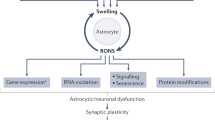Abstract
Hepatic encephalopathy is the main cognitive dysfunction in cirrhotic patients associated with impaired prognosis. Hyperammonemia plus inflammatory response do play a crucial role on hepatic encephalopathy. However, in some patients HE appeared without hyperammonemia and patients with increased levels of ammonia could not show cognitive dysfunction. This has led to investigate other factors that could act in a synergistic way. Diabetes mellitus and insulin resistance are characterized by releasing and enhancing these pro-inflammatory cytokines and, additionally, has been related to hepatic encephalopathy. Indeed, patients with diabetes showed raised risk of over hepatic encephalopathy in comparison with non-cirrhotics. Type 2 diabetes mellitus could impair hepatic encephalopathy by different mechanisms that include: a) increasing glutaminase activity; b) impairing gut motility and promoting constipation, intestinal bacterial overgrowth and bacterial translocation. Despite of insufficient clarity about the practicability of anti-diabetic therapy and the most efficacious therapy, we would have to pay a special attention to the management of type 2 diabetes mellitus and insulin resistance in cirrhotic patients.

Similar content being viewed by others
Abbreviations
- HE:
-
Hepatic encephalopathy
- DM:
-
Diabetes mellitus
- T2DM:
-
Type 2 diabetes mellitus
- HD:
-
Hepatogenous diabetes
- TNFα:
-
Tumor necrosis factor alpha
- IL-6:
-
Interleukin 6
- GLS:
-
Glutaminase
- KGLS:
-
Kidney-type glutaminase
- LGLS:
-
Liver-type glutaminase
- BBB:
-
Blood brain barrier
- IR:
-
Insulin resistance
- SIBO:
-
Small intestine bacterial overgrowth
- MHE:
-
Minimal hepatic encephalopathy
References
Baffy G (2012) Editorial: hepatocellular carcinoma in type 2 diabetes: more than meets the eye. Am J Gastroenterol 107(1):53–55
Baglietto-Vargas D, Lopez-Tellez JF, Moreno-Gonzalez I, Gutierrez A, Aledo JC (2004) Segregation of two glutaminase isoforms in islets of Langerhans. Biochem J 381:483–487
Basu S, Zethelius B, Helmersson B et al (2011) Cytokine-mediated inflammation is independently associated with insulin sensitivity measured by the euglycemic insulin clamp in a community-based cohort of elderly men. Int J Clin Exp Med 4(2):164–168
Bustamante J, Rimola A, Ventura PJ et al (1999) Prognostic significance of hepatic encephalopathy in patients with cirrhosis. J Hepatol 30:890–895
Chow LS, Albright RC, Bigelow ML, Toffolo G, Cobelli C, Nair KS (2006) Mechanism of insulin’s anabolic effect on muscle: measurements of muscle protein synthesis and breakdown using aminoacyl-tRNA and other surrogate measures. Am J Physiol Endocrinol Metab 291:E729–E736
Garcia-Compean D, Jaquez-Quintana JO, Gonzalez-Gonzalez JA et al (2009) Liver cirrhosis and diabetes: risk factors, pathophysiology, clinical implications and management. World J Gastroenterol 15:280–288
Goral V, Atayan Y, Kaplan A (2011) The relation between pathogenesis of liver cirrhosis, hepatic encephalopathy and serum cytokine levels: what is the role of tumor necrosis factor alpha? Hepato-Gastroenterology 58:943–948
Gundling F, Schmidtler F, Hapfelmeier A et al (2011) Fecal calprotectin is a useful screening parameter for hepatic encephalopathy and spontaneous bacterial peritonitis in cirrhosis. Liver Int 31:1406–1415
Jun DW, Kim KT, Lee OY et al (2010) Association between small intestinal bacterial overgrowth and peripheral bacterial DNA in cirrhotic patients. Dig Dis Sci 55:1465–1471
Kalaitzakis E, Olsson R, Henfridsson P et al (2007) Malnutrition and diabetes mellitus are related to hepatic encephalopathy in patients with liver cirrhosis. Liver Int 27(9):1194–1201
Krabbe KS, Reichenberg A, Yirmiya R, Smed A, Pedersen BK, Bruunsgaard H (2005) Low-dose endotoxemia and human neuropsychological functions. Brain Behav Immun 19(5):453–460
Montoliu C, Piedrafita B, Serra MA et al (2009) IL-6 and IL-18 in blood may discriminate cirrhotic patients with and without minimal hepatic encephalopathy. J Clin Gastroenterol 43(3):272–279
Nelson TE, Netzeband JG, Gruol DL (2004) Chronic interleukin-6 exposure alters metabotropic glutamate receptor-activated calcium signalling in cerebellar Purkinje neurons. Eur J Neurosci 20:2387–2400
Odeh M, Sabo E, Srugo I, Oliven A (2004) Serum levels of tumor necrosis factor-alpha correlate with severity of hepatic encephalopathy due to chronic liver failure. Liver Int 24(2):110–116
Romero-Gómez M (2005) Role of phosphate-activated glutaminase in the pathogenesis of hepatic encephalopathy. Metab Brain Dis 20:319–325
Romero-Gómez M (2010) Pharmacotherapy of hepatic encephalopathy in cirrhosis. Expert Opin Pharmacother 11:1317–1327
Romero-Gómez M, Boza F, García-Valdecasas MS, García E, Aguilar-Reina J (2001) Subclinical hepatic encephalopathy predicts the development of overt hepatic encephalopathy. Am J Gastroenterol 96:2718–2723
Romero-Gómez M, Ramos-Guerrero R, Grande L et al (2004) Intestinal glutaminase activity is increased in liver cirrhosis and correlates with minimal hepatic encephalopathy. J Hepatol 41(1):49–54
Sigal SH, Stanca CM, Kontorinis N, Bodian C, Ryan E (2006) Diabetes mellitus is associated with hepatic encephalopathy in patients with HCV cirrhosis. Am J Gastroenterol 101(7):1490–1496
Squires SA, Ewart HS, McCarthy C, Brosnan ME, Brosnan JT (1997) Regulation of hepatic glutaminase in the streptozotocin-induced diabetic rat. Diabetes 46(12):1945–1949
Watford M, Smith EM, Erbelding EJ (1984) The regulation of phosphate-activated glutaminase activity and glutamine metabolism in the streptozotocin-diabetic rat. Biochem J 224:207–214
Weaver JD, Huang MH, Albert M, Harris T, Rowe JW, Seeman TE (2002) Interleukin-6 and risk of cognitive decline: MacArthur studies of successful aging. Neurology 59:371–378
Conflict of interest
The authors declare that they have no conflict of interest.
Author information
Authors and Affiliations
Corresponding author
Rights and permissions
About this article
Cite this article
Ampuero, J., Ranchal, I., del Mar Díaz-Herrero, M. et al. Role of diabetes mellitus on hepatic encephalopathy. Metab Brain Dis 28, 277–279 (2013). https://doi.org/10.1007/s11011-012-9354-2
Received:
Accepted:
Published:
Issue Date:
DOI: https://doi.org/10.1007/s11011-012-9354-2




